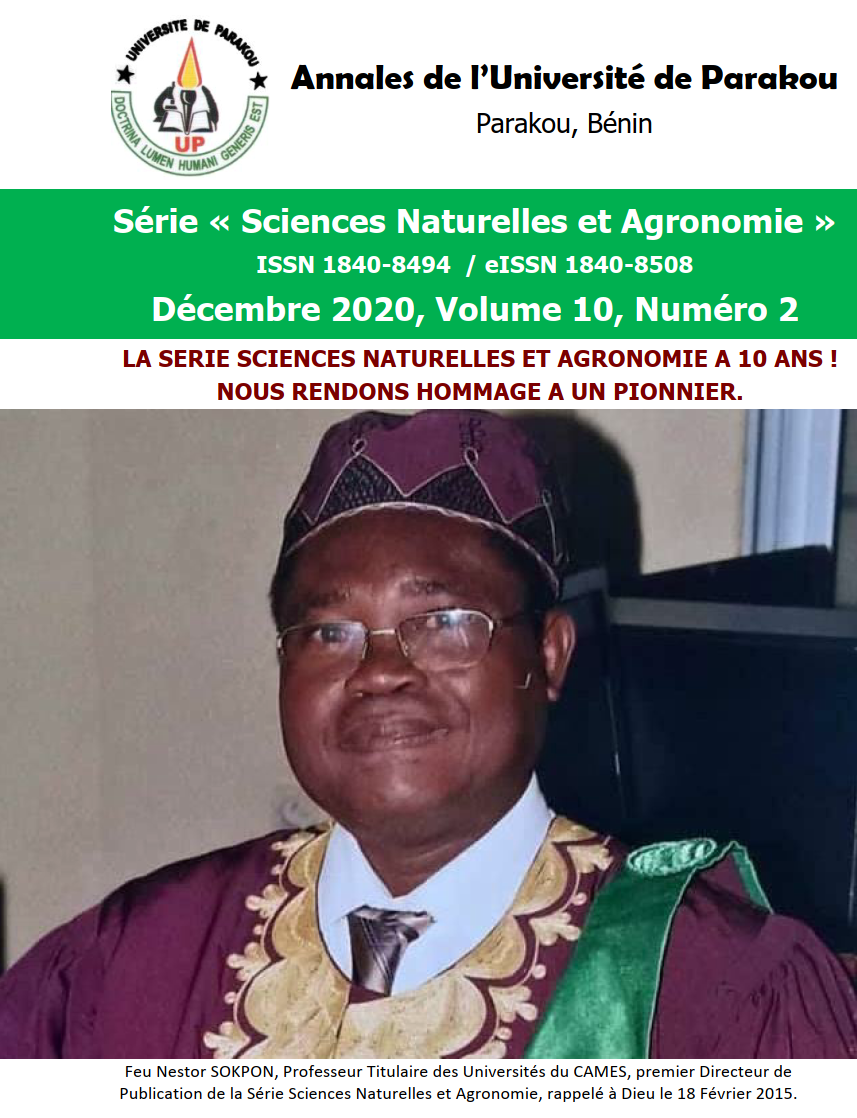Cartographie et analyse spatiale de la dégradation des terres dans le sud-est du Togo : une approche basée sur la télédétection
DOI :
https://doi.org/10.56109/aup-sna.v9i1.64Mots-clés :
Dégradation des terres, télédétection, indices spectraux, Sud-Est TogoRésumé
Le présent travail consiste en l’utilisation des techniques de télédétection afin de caractériser et d’évaluer la dégradation des terres dans le Sud-Est Togo. Le problème de dégradation des terres dans cette partie du Togo est dû à de fortes pressions d’origine humaine relevant des différentes activités économiques. L’approche adoptée relève de la géomatique basée sur le calcul des indices (végétation et sol) et l’analyse spatiale. A cet effet, à partir de deux scènes Landsat mosaïquées, des indices tels que le NDVI, le DVI, le MSAVI2, le TCT-B, le NDBI et le BSI ont été calculés, puis combinés. Une meilleure combinaison fut retenue et a permis la classification des images suivant l’intensité de dégradation des terres. La validation de la carte obtenue a été faite sur la base de la vérification terrain et des études antérieures sur la thématique dans le secteur. Les résultats obtenus ont révélé que les terres fortement dégradées représentent 54,9 % de l’ensemble des terres contre 41 % pour les terres modérément dégradées. La faible dégradation quant à elle, ne concerne que 4,1 % des terres dans le secteur d’étude. La répartition par unité administrative a montré que les terres les plus dégradées sont localisées essentiellement dans la préfecture de Vo. L’évaluation qualitative des résultats a montré l’atout de ces indicateurs spectraux à discriminer les différents niveaux de dégradation des terres dans le secteur d’étude. L’étude permet ainsi d’apprécier l’étendue du phénomène dans le souci de conservation des terres dans un espace fortement anthropisé.
Téléchargements
Métriques
Références
Bannari A. Morin D. Bonn F. & Huete A. R. 1995. A review of vegetation indices. Remote Sensing Reviews, 13: 95-120. DOI: https://doi.org/10.1080/02757259509532298
Benedine A. Robert T. A. & Abbas I. I. 2011. The Impact of Spatial distribution of solid waste dumps on infrastructure in Samaru, Zaria, Nigeria using GIS. Research Journal of Information Technology, 3 (3): 113-117.
Chen W. Liu L. Zhang C. Wang J. Wang J. & Pan Y. 2014. Monitoring the seasonal bare soil areas in Beijing using multitemporal TM images. In Proceedings of the 2004 IEEE International Geoscience and Remote Sensing Symposium (IGARSS’04), Anchorage, AK, USA, 20–24 September 2004.
Dabin B. 1956. Contribution à l’étude de la fertilité des Terres de Barre. Agron. trop. XI, 4: 490-506.
Djegui N. 1982. Essai de caractérisation de l’état de dégradation des terres de barres. Rapport IRAT-CIRAD.
Dome D. 1985. Carte pédologique de la région de Tsévié (Togo) au 1/50 000. Contribution à l'étude pédo-agronomique des terres de Barre du Togo. Rapp. ORSTOM, Lomé, Togo.
Eswaran E., Lal R. & Reich F. 2001. Land degradation: an overview: 1-5. In: Bridges E. M., Hannam I. D., Oldeman L. R., Pening de Vries F. W. T., Scherr S. J. & Sompatpanit S. (eds.), Responses to Land Degradation. Proc. 2nd. International Conference on Land Degradation and Desertification, Khon Kaen, Thailand. Oxford Press, New Delhi, India.
Gao J. & Liu Y. 2008. Mapping of land degradation from space: A comparative study of Landsat ETM+ and ASTER data. International Journal of Remote Sensing, 29 (14): 4029-4043. DOI: https://doi.org/10.1080/01431160801891887
Gao J. 2008. Detection of changes in land degradation in northeast China from Landsat TM and Aster data. The International Archives of the Photogrammetry, Remote Sensing and Spatial Information Sciences, 37: 1533-1538.
Gibson D. J. D. 2007. Land degradation in the Limpopo province, South Africa. MSc thesis, University of the Witwatersrand, School of Animal, Plant and Environmental Sciences, Johannesburg, South Africa.
Huete A., Gao X., Kim H. J., Miura T., Borghi C. & Ojeda R. 2002. Characterization of land degradation in central Argentina with hyperspectral AVIRIS and EO-1 data. 17th WCSS, 14-21 August 2002, Thailand. Symposium 46, Paper n°987.
Karnieli A. Gilad U. Ponzet M. Svoray T. Mirzadinov R. & Fedorina O. 2008. Assessing land-cover change and degradation in the Central Asian deserts using satellite image processing and geostatistical methods. Journal of Arid Environments, 72: 2093-2105. DOI: https://doi.org/10.1016/j.jaridenv.2008.07.009
Kauth R. J. & Thomas G. S. 1976. The Tasselled Cap-A Graphic Description of the Spectral Temporal Development of Agricultural Crops as Seen by Landsat. Paper presented at the LARS Symposia, Proceedings of the Symposium on Machine Processing of Remotely Sensed Data, Purdue University, West Lafayette, IN, June 29-July 1, 4B41-4B51.
Kruse F. A. 2004. Comparison of ATREM, ACORN, and FLAASH Atmospheric corrections using lowaltitude AVIRIS data of Boulder, Colorado. Proceedings of 13th JPL Airborne Geoscience Workshop, Pasadena, CA, USA, 31 March-2 April 2004: 1-10.
Lamouroux M., (1969) : Carte pédologique du Togo au 1/1.000.000. Notice explicative n°34, ORSTOM. Paris, France.
Lillesand T. M., Kiefer R. W. & Chipman J. W. 2004. Remote sensing and image interpretation. 5th Edition, John Wiley & Son, New York, USA.
Liu Y. Wang T. Ma L. & Wang N. (2014). Spectral calibration of hyperspectral data observed from a hyperspectrometer loaded on an unmanned aerial vehicle platform. IEEE Journal of Selected Topics in Applied Earth Observations and Remote Sensing, 7 (6): 2630-2638. DOI: https://doi.org/10.1109/JSTARS.2014.2329891
Mambo J. & Archer E. 2007. An assessment of land degradation in the Save catchment of Zimbabwe. Area, 39 (3): 380-391. DOI: https://doi.org/10.1111/j.1475-4762.2007.00728.x
Marquette C. 1997. Population and environment relationships in developing countries: A select review of approaches and methods. Working Paper Chr. Michelsen Institute Development Studies and Human Rights, Bergen, Norway.
MEA. 2005. Living beyond our means: Natural assets and human well-being. Statement from the Millennium Ecosystem Assessment Board.
Mitchell J. J., Glenn N. F., Anderson M. O., Hruska R. C., Halford A., C. Baun & Nydegger N. 2012. Unmanned aerial vehicle (UAV) hyperspectral remote sensing for dryland vegetation monitoring. Hyperspectral Image and Signal Processing (WHISPERS), 4th Workshop. IEEE, Shanghai, China: 1-10. DOI: https://doi.org/10.1109/WHISPERS.2012.6874315
Poss R. 1987. La dégradation des terres de Barre du Togo : mythe ou réalité ? Proceedings of the 8th meeting of the West and Central Africa sub-committee on correlation of soils for land development, EA.O., Yaoundé (Cameroon) January 19 -28, 1987: 155-159
Prince K Guo X & Stiles J. M. 2002. Optimal Landsat TM band combinations and vegetation indices for discrimination of six grassland types in eastern Kansas. International Journal of Remote Sensing, 23: 5031-5042. DOI: https://doi.org/10.1080/01431160210121764
Qi J. Chehbouni A. Huete A. R. & Kerr Y. H. 1994. Modified Soil Adjusted Vegetation Index (MSAVI). Remote Sens Environ 48:119-126. DOI: https://doi.org/10.1016/0034-4257(94)90134-1
Raunet M. 1971. Contribution à l'étude pédo-agronomique des "terres de Barre" du Dahomey et du Togo. L'Agro. Trop.: 1049-1069.
Reynolds J. F. & Stafford Smith D. M. 2002. Global desertification: do humans create deserts? : 1-22 In: Stafford-Smith M. & Reynolds J. F. (eds.), Do Humans Create Deserts? Dahlem University Press, Berlin, Germany.
Richardson A. J. & Wiegand C. L. 1977. Distinguishing vegetation from soil background in formation. Photogramm. ENG. Remote sensing 43: 1541-1552.
Romm J. 2011. Desertification: the next dust bowl. Nature, 478: 450-451. DOI: https://doi.org/10.1038/478450a
Rouse, J. W., Haas R. H., Schell J. A., & Deering D. W. 1973. Monitoring Vegetation Systems in the Great Plains with ERTS. In Paper presented at the Third ERTS Symposium, NASA SP-351, Vol.I, December 10-14, Washington, DC: NASA: 309-317.
Soulama S. Kadeba A. Nacoulma B. M. I. Traoré S. Bachmann Y. & Thiombiano A. 2015. Impact des activités anthropiques sur la dynamique de la végétation de la réserve partielle de faune de Pama et de ses périphéries (sud-est du Burkina Faso) dans un contexte de variabilité climatique. J. of Appl. Biosci, 87: 8047-8064. DOI: https://doi.org/10.4314/jab.v87i1.6
Tchibozo E. A. & Toundoh O. P. 2014. Détection localisée des zones dégradées de végétation par télédétection : application à la zone de transition entre le bassin sédimentaire et le socle cristallin (Centre-Bénin). International Journal of Innovation and Scientific Research, 11 (2): 477-493.
Viellefon J. & Millette G. 1965. Etudes pédo-hydrologiques au Togo. Vol. II : les sols de la région maritime et des savanes. ONU/ FAO, Rome, Italie - ORSTOM, Paris, France.
Wessels K. J. Prince S. D. Frost P. E. & Van Zyl D. 2004. Assessing the effects of human-induced land degradation in the former homelands of northern South Africa with a 1 km AVHRR NDVI time series. Remote Sensing and the Environment, 91: 47-67. DOI: https://doi.org/10.1016/j.rse.2004.02.005
Zha Y. Gao J. & Ni S. 2003. Use of normalized difference built-up index in automatically mapping urban areas from TM imagery. International Journal of Remote Sensing, 24 (3): 583-594. DOI: https://doi.org/10.1080/01431160304987














